Quality Improvement Initiative: Enhancing Patient Care and Safety
VerifiedAdded on 2022/10/11
|7
|1990
|9
Report
AI Summary
This report proposes a quality improvement initiative to address the issue of inadequate nurse staffing and its negative impact on patient safety, particularly among elderly patients, and the subsequent increase in falls. The purpose of the initiative is to improve the quality of care by enhancing nurse efficiency, thereby reducing the risk of falls. The target population includes elderly patients (65+), registered nurses, and healthcare workers. The benefits include improved patient outcomes, reduced healthcare burdens, and enhanced hospital ratings. Interprofessional collaboration is crucial, involving healthcare professionals, administrators, patients, and their families. The project's cost involves training and education for staff, with evaluation conducted through inspections, surveys, and record analysis. The report emphasizes the importance of this initiative in creating a healthier and safer environment for patients and improving the overall healthcare experience. The report includes the executive summary, a detailed analysis of the problem, the proposed solution, and the expected outcomes.
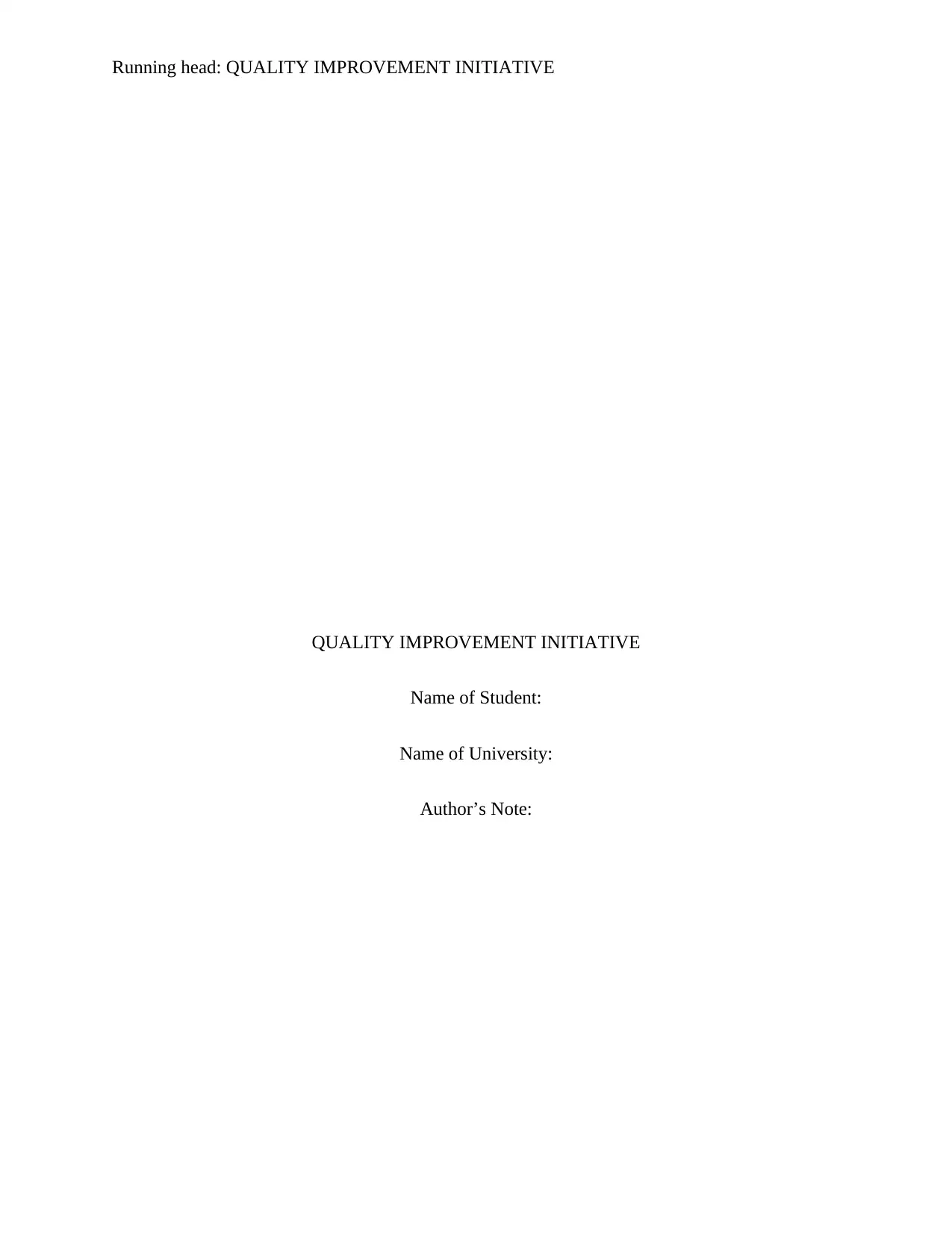
Running head: QUALITY IMPROVEMENT INITIATIVE
QUALITY IMPROVEMENT INITIATIVE
Name of Student:
Name of University:
Author’s Note:
QUALITY IMPROVEMENT INITIATIVE
Name of Student:
Name of University:
Author’s Note:
Paraphrase This Document
Need a fresh take? Get an instant paraphrase of this document with our AI Paraphraser
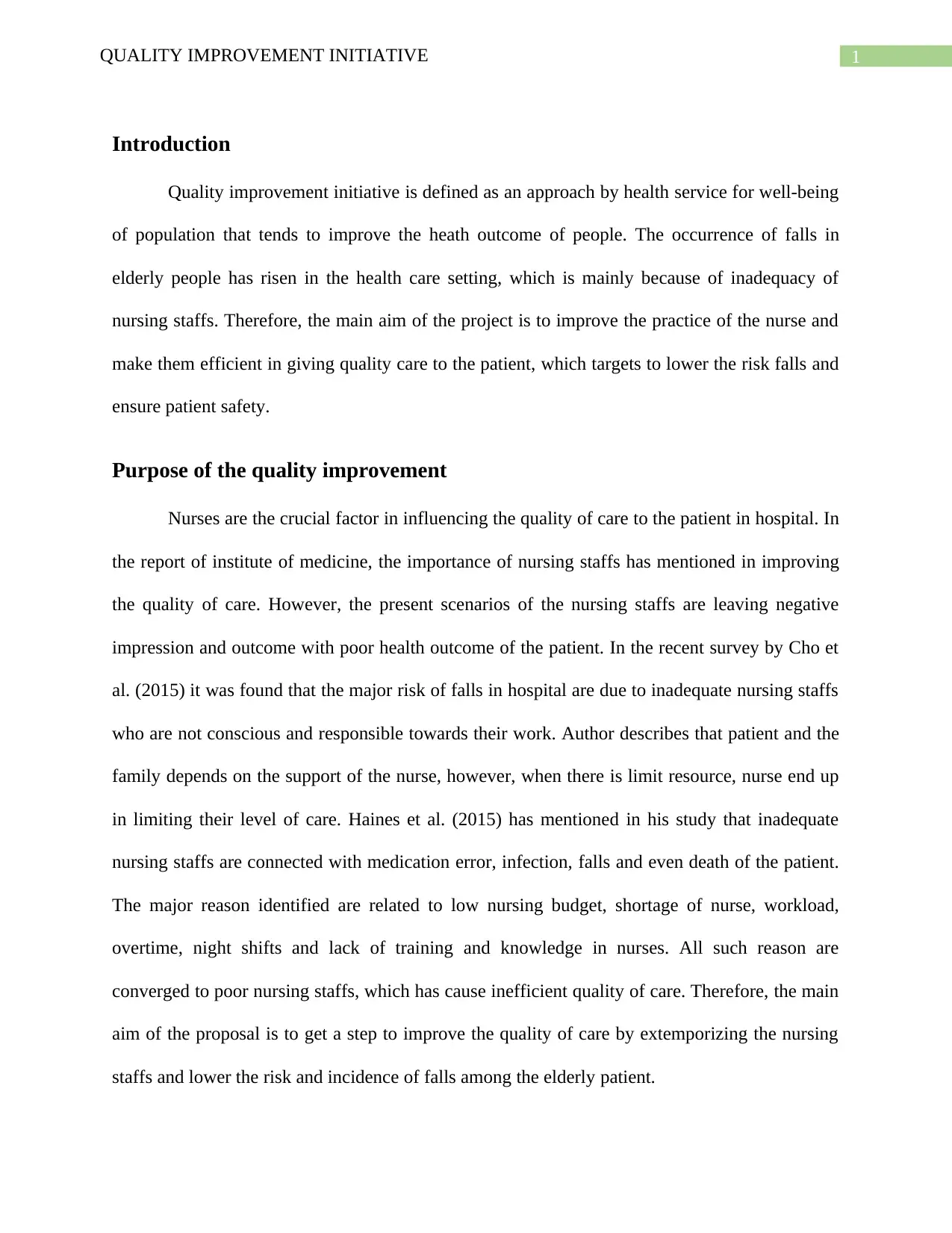
1QUALITY IMPROVEMENT INITIATIVE
Introduction
Quality improvement initiative is defined as an approach by health service for well-being
of population that tends to improve the heath outcome of people. The occurrence of falls in
elderly people has risen in the health care setting, which is mainly because of inadequacy of
nursing staffs. Therefore, the main aim of the project is to improve the practice of the nurse and
make them efficient in giving quality care to the patient, which targets to lower the risk falls and
ensure patient safety.
Purpose of the quality improvement
Nurses are the crucial factor in influencing the quality of care to the patient in hospital. In
the report of institute of medicine, the importance of nursing staffs has mentioned in improving
the quality of care. However, the present scenarios of the nursing staffs are leaving negative
impression and outcome with poor health outcome of the patient. In the recent survey by Cho et
al. (2015) it was found that the major risk of falls in hospital are due to inadequate nursing staffs
who are not conscious and responsible towards their work. Author describes that patient and the
family depends on the support of the nurse, however, when there is limit resource, nurse end up
in limiting their level of care. Haines et al. (2015) has mentioned in his study that inadequate
nursing staffs are connected with medication error, infection, falls and even death of the patient.
The major reason identified are related to low nursing budget, shortage of nurse, workload,
overtime, night shifts and lack of training and knowledge in nurses. All such reason are
converged to poor nursing staffs, which has cause inefficient quality of care. Therefore, the main
aim of the proposal is to get a step to improve the quality of care by extemporizing the nursing
staffs and lower the risk and incidence of falls among the elderly patient.
Introduction
Quality improvement initiative is defined as an approach by health service for well-being
of population that tends to improve the heath outcome of people. The occurrence of falls in
elderly people has risen in the health care setting, which is mainly because of inadequacy of
nursing staffs. Therefore, the main aim of the project is to improve the practice of the nurse and
make them efficient in giving quality care to the patient, which targets to lower the risk falls and
ensure patient safety.
Purpose of the quality improvement
Nurses are the crucial factor in influencing the quality of care to the patient in hospital. In
the report of institute of medicine, the importance of nursing staffs has mentioned in improving
the quality of care. However, the present scenarios of the nursing staffs are leaving negative
impression and outcome with poor health outcome of the patient. In the recent survey by Cho et
al. (2015) it was found that the major risk of falls in hospital are due to inadequate nursing staffs
who are not conscious and responsible towards their work. Author describes that patient and the
family depends on the support of the nurse, however, when there is limit resource, nurse end up
in limiting their level of care. Haines et al. (2015) has mentioned in his study that inadequate
nursing staffs are connected with medication error, infection, falls and even death of the patient.
The major reason identified are related to low nursing budget, shortage of nurse, workload,
overtime, night shifts and lack of training and knowledge in nurses. All such reason are
converged to poor nursing staffs, which has cause inefficient quality of care. Therefore, the main
aim of the proposal is to get a step to improve the quality of care by extemporizing the nursing
staffs and lower the risk and incidence of falls among the elderly patient.
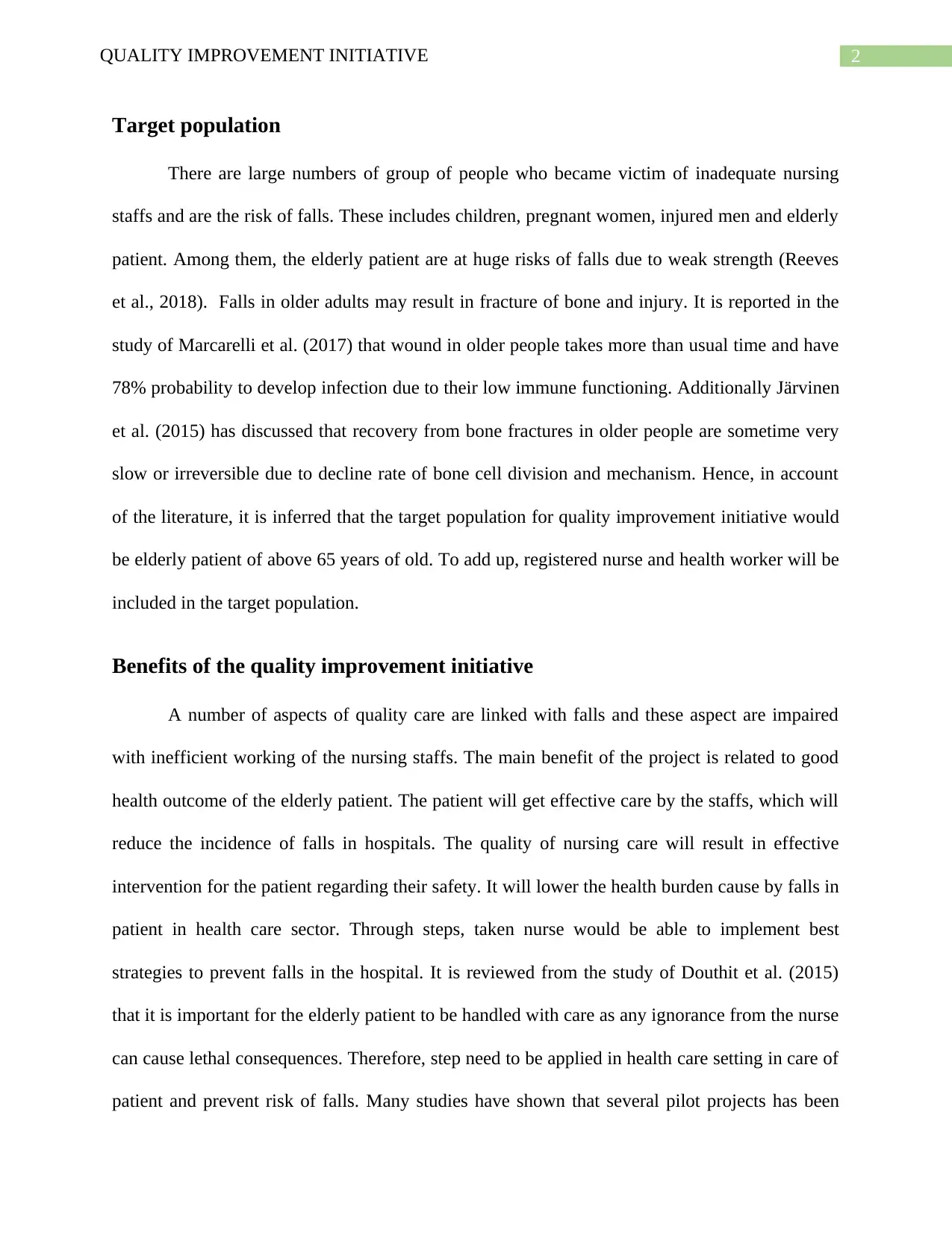
2QUALITY IMPROVEMENT INITIATIVE
Target population
There are large numbers of group of people who became victim of inadequate nursing
staffs and are the risk of falls. These includes children, pregnant women, injured men and elderly
patient. Among them, the elderly patient are at huge risks of falls due to weak strength (Reeves
et al., 2018). Falls in older adults may result in fracture of bone and injury. It is reported in the
study of Marcarelli et al. (2017) that wound in older people takes more than usual time and have
78% probability to develop infection due to their low immune functioning. Additionally Järvinen
et al. (2015) has discussed that recovery from bone fractures in older people are sometime very
slow or irreversible due to decline rate of bone cell division and mechanism. Hence, in account
of the literature, it is inferred that the target population for quality improvement initiative would
be elderly patient of above 65 years of old. To add up, registered nurse and health worker will be
included in the target population.
Benefits of the quality improvement initiative
A number of aspects of quality care are linked with falls and these aspect are impaired
with inefficient working of the nursing staffs. The main benefit of the project is related to good
health outcome of the elderly patient. The patient will get effective care by the staffs, which will
reduce the incidence of falls in hospitals. The quality of nursing care will result in effective
intervention for the patient regarding their safety. It will lower the health burden cause by falls in
patient in health care sector. Through steps, taken nurse would be able to implement best
strategies to prevent falls in the hospital. It is reviewed from the study of Douthit et al. (2015)
that it is important for the elderly patient to be handled with care as any ignorance from the nurse
can cause lethal consequences. Therefore, step need to be applied in health care setting in care of
patient and prevent risk of falls. Many studies have shown that several pilot projects has been
Target population
There are large numbers of group of people who became victim of inadequate nursing
staffs and are the risk of falls. These includes children, pregnant women, injured men and elderly
patient. Among them, the elderly patient are at huge risks of falls due to weak strength (Reeves
et al., 2018). Falls in older adults may result in fracture of bone and injury. It is reported in the
study of Marcarelli et al. (2017) that wound in older people takes more than usual time and have
78% probability to develop infection due to their low immune functioning. Additionally Järvinen
et al. (2015) has discussed that recovery from bone fractures in older people are sometime very
slow or irreversible due to decline rate of bone cell division and mechanism. Hence, in account
of the literature, it is inferred that the target population for quality improvement initiative would
be elderly patient of above 65 years of old. To add up, registered nurse and health worker will be
included in the target population.
Benefits of the quality improvement initiative
A number of aspects of quality care are linked with falls and these aspect are impaired
with inefficient working of the nursing staffs. The main benefit of the project is related to good
health outcome of the elderly patient. The patient will get effective care by the staffs, which will
reduce the incidence of falls in hospitals. The quality of nursing care will result in effective
intervention for the patient regarding their safety. It will lower the health burden cause by falls in
patient in health care sector. Through steps, taken nurse would be able to implement best
strategies to prevent falls in the hospital. It is reviewed from the study of Douthit et al. (2015)
that it is important for the elderly patient to be handled with care as any ignorance from the nurse
can cause lethal consequences. Therefore, step need to be applied in health care setting in care of
patient and prevent risk of falls. Many studies have shown that several pilot projects has been
⊘ This is a preview!⊘
Do you want full access?
Subscribe today to unlock all pages.

Trusted by 1+ million students worldwide
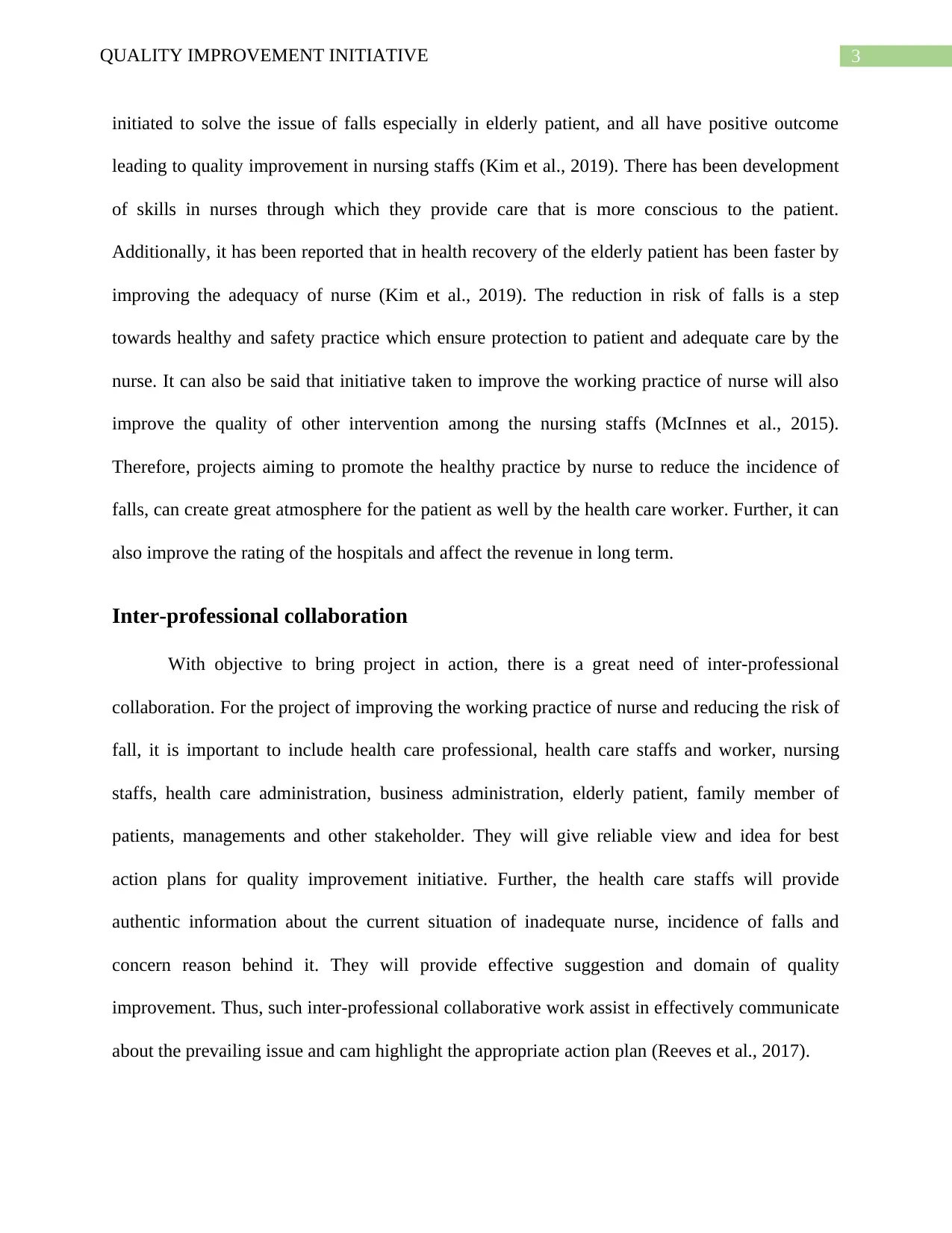
3QUALITY IMPROVEMENT INITIATIVE
initiated to solve the issue of falls especially in elderly patient, and all have positive outcome
leading to quality improvement in nursing staffs (Kim et al., 2019). There has been development
of skills in nurses through which they provide care that is more conscious to the patient.
Additionally, it has been reported that in health recovery of the elderly patient has been faster by
improving the adequacy of nurse (Kim et al., 2019). The reduction in risk of falls is a step
towards healthy and safety practice which ensure protection to patient and adequate care by the
nurse. It can also be said that initiative taken to improve the working practice of nurse will also
improve the quality of other intervention among the nursing staffs (McInnes et al., 2015).
Therefore, projects aiming to promote the healthy practice by nurse to reduce the incidence of
falls, can create great atmosphere for the patient as well by the health care worker. Further, it can
also improve the rating of the hospitals and affect the revenue in long term.
Inter-professional collaboration
With objective to bring project in action, there is a great need of inter-professional
collaboration. For the project of improving the working practice of nurse and reducing the risk of
fall, it is important to include health care professional, health care staffs and worker, nursing
staffs, health care administration, business administration, elderly patient, family member of
patients, managements and other stakeholder. They will give reliable view and idea for best
action plans for quality improvement initiative. Further, the health care staffs will provide
authentic information about the current situation of inadequate nurse, incidence of falls and
concern reason behind it. They will provide effective suggestion and domain of quality
improvement. Thus, such inter-professional collaborative work assist in effectively communicate
about the prevailing issue and cam highlight the appropriate action plan (Reeves et al., 2017).
initiated to solve the issue of falls especially in elderly patient, and all have positive outcome
leading to quality improvement in nursing staffs (Kim et al., 2019). There has been development
of skills in nurses through which they provide care that is more conscious to the patient.
Additionally, it has been reported that in health recovery of the elderly patient has been faster by
improving the adequacy of nurse (Kim et al., 2019). The reduction in risk of falls is a step
towards healthy and safety practice which ensure protection to patient and adequate care by the
nurse. It can also be said that initiative taken to improve the working practice of nurse will also
improve the quality of other intervention among the nursing staffs (McInnes et al., 2015).
Therefore, projects aiming to promote the healthy practice by nurse to reduce the incidence of
falls, can create great atmosphere for the patient as well by the health care worker. Further, it can
also improve the rating of the hospitals and affect the revenue in long term.
Inter-professional collaboration
With objective to bring project in action, there is a great need of inter-professional
collaboration. For the project of improving the working practice of nurse and reducing the risk of
fall, it is important to include health care professional, health care staffs and worker, nursing
staffs, health care administration, business administration, elderly patient, family member of
patients, managements and other stakeholder. They will give reliable view and idea for best
action plans for quality improvement initiative. Further, the health care staffs will provide
authentic information about the current situation of inadequate nurse, incidence of falls and
concern reason behind it. They will provide effective suggestion and domain of quality
improvement. Thus, such inter-professional collaborative work assist in effectively communicate
about the prevailing issue and cam highlight the appropriate action plan (Reeves et al., 2017).
Paraphrase This Document
Need a fresh take? Get an instant paraphrase of this document with our AI Paraphraser
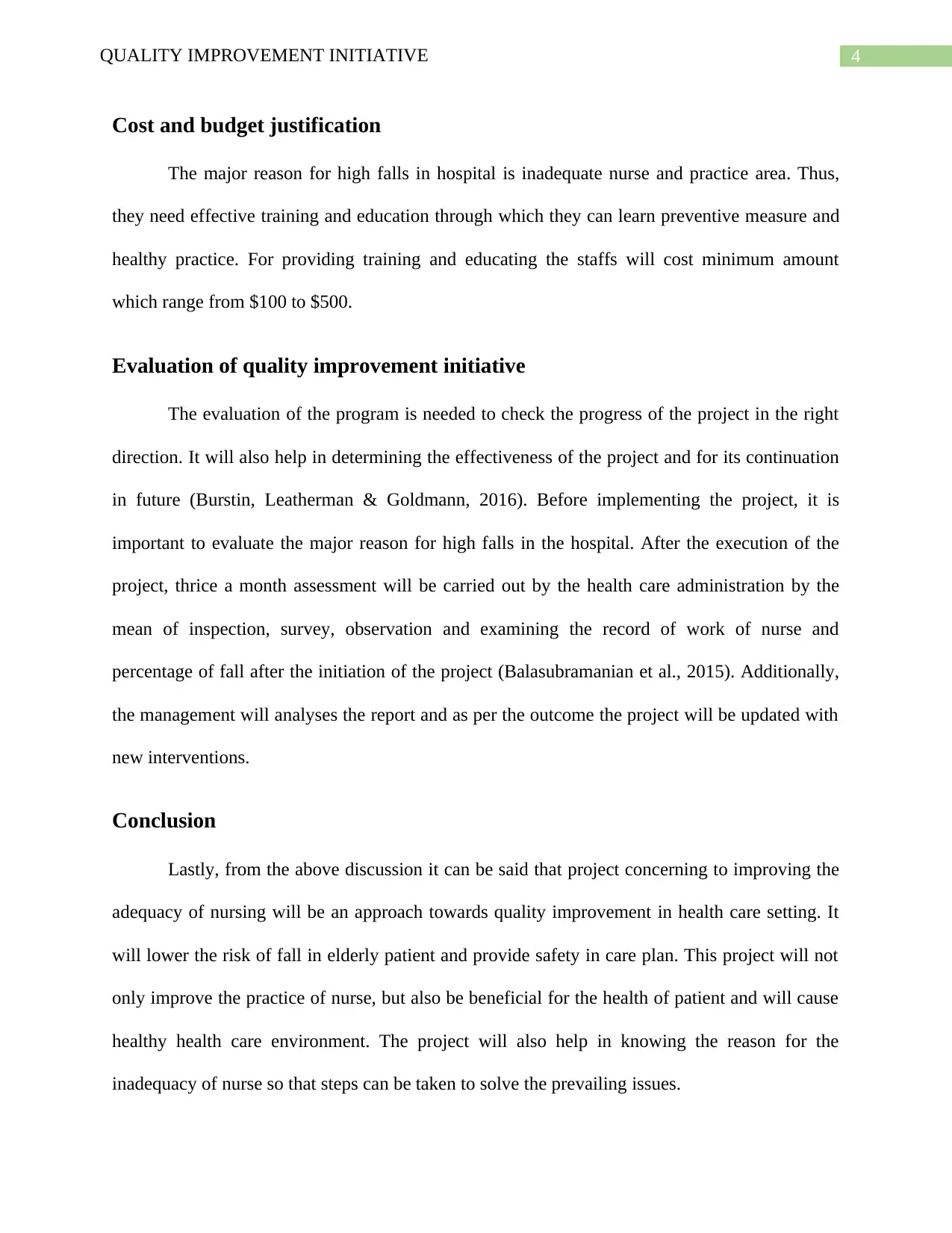
4QUALITY IMPROVEMENT INITIATIVE
Cost and budget justification
The major reason for high falls in hospital is inadequate nurse and practice area. Thus,
they need effective training and education through which they can learn preventive measure and
healthy practice. For providing training and educating the staffs will cost minimum amount
which range from $100 to $500.
Evaluation of quality improvement initiative
The evaluation of the program is needed to check the progress of the project in the right
direction. It will also help in determining the effectiveness of the project and for its continuation
in future (Burstin, Leatherman & Goldmann, 2016). Before implementing the project, it is
important to evaluate the major reason for high falls in the hospital. After the execution of the
project, thrice a month assessment will be carried out by the health care administration by the
mean of inspection, survey, observation and examining the record of work of nurse and
percentage of fall after the initiation of the project (Balasubramanian et al., 2015). Additionally,
the management will analyses the report and as per the outcome the project will be updated with
new interventions.
Conclusion
Lastly, from the above discussion it can be said that project concerning to improving the
adequacy of nursing will be an approach towards quality improvement in health care setting. It
will lower the risk of fall in elderly patient and provide safety in care plan. This project will not
only improve the practice of nurse, but also be beneficial for the health of patient and will cause
healthy health care environment. The project will also help in knowing the reason for the
inadequacy of nurse so that steps can be taken to solve the prevailing issues.
Cost and budget justification
The major reason for high falls in hospital is inadequate nurse and practice area. Thus,
they need effective training and education through which they can learn preventive measure and
healthy practice. For providing training and educating the staffs will cost minimum amount
which range from $100 to $500.
Evaluation of quality improvement initiative
The evaluation of the program is needed to check the progress of the project in the right
direction. It will also help in determining the effectiveness of the project and for its continuation
in future (Burstin, Leatherman & Goldmann, 2016). Before implementing the project, it is
important to evaluate the major reason for high falls in the hospital. After the execution of the
project, thrice a month assessment will be carried out by the health care administration by the
mean of inspection, survey, observation and examining the record of work of nurse and
percentage of fall after the initiation of the project (Balasubramanian et al., 2015). Additionally,
the management will analyses the report and as per the outcome the project will be updated with
new interventions.
Conclusion
Lastly, from the above discussion it can be said that project concerning to improving the
adequacy of nursing will be an approach towards quality improvement in health care setting. It
will lower the risk of fall in elderly patient and provide safety in care plan. This project will not
only improve the practice of nurse, but also be beneficial for the health of patient and will cause
healthy health care environment. The project will also help in knowing the reason for the
inadequacy of nurse so that steps can be taken to solve the prevailing issues.
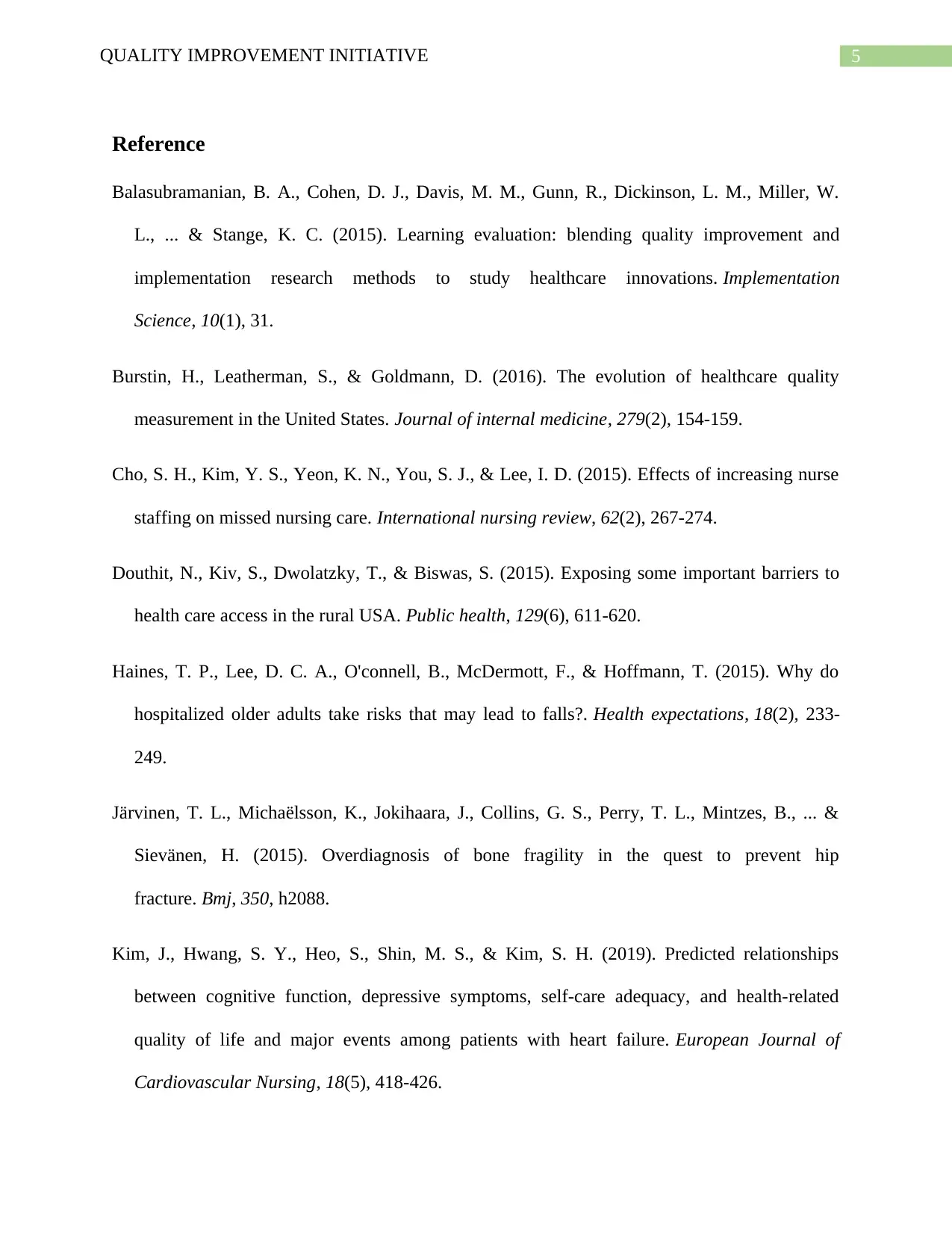
5QUALITY IMPROVEMENT INITIATIVE
Reference
Balasubramanian, B. A., Cohen, D. J., Davis, M. M., Gunn, R., Dickinson, L. M., Miller, W.
L., ... & Stange, K. C. (2015). Learning evaluation: blending quality improvement and
implementation research methods to study healthcare innovations. Implementation
Science, 10(1), 31.
Burstin, H., Leatherman, S., & Goldmann, D. (2016). The evolution of healthcare quality
measurement in the United States. Journal of internal medicine, 279(2), 154-159.
Cho, S. H., Kim, Y. S., Yeon, K. N., You, S. J., & Lee, I. D. (2015). Effects of increasing nurse
staffing on missed nursing care. International nursing review, 62(2), 267-274.
Douthit, N., Kiv, S., Dwolatzky, T., & Biswas, S. (2015). Exposing some important barriers to
health care access in the rural USA. Public health, 129(6), 611-620.
Haines, T. P., Lee, D. C. A., O'connell, B., McDermott, F., & Hoffmann, T. (2015). Why do
hospitalized older adults take risks that may lead to falls?. Health expectations, 18(2), 233-
249.
Järvinen, T. L., Michaëlsson, K., Jokihaara, J., Collins, G. S., Perry, T. L., Mintzes, B., ... &
Sievänen, H. (2015). Overdiagnosis of bone fragility in the quest to prevent hip
fracture. Bmj, 350, h2088.
Kim, J., Hwang, S. Y., Heo, S., Shin, M. S., & Kim, S. H. (2019). Predicted relationships
between cognitive function, depressive symptoms, self-care adequacy, and health-related
quality of life and major events among patients with heart failure. European Journal of
Cardiovascular Nursing, 18(5), 418-426.
Reference
Balasubramanian, B. A., Cohen, D. J., Davis, M. M., Gunn, R., Dickinson, L. M., Miller, W.
L., ... & Stange, K. C. (2015). Learning evaluation: blending quality improvement and
implementation research methods to study healthcare innovations. Implementation
Science, 10(1), 31.
Burstin, H., Leatherman, S., & Goldmann, D. (2016). The evolution of healthcare quality
measurement in the United States. Journal of internal medicine, 279(2), 154-159.
Cho, S. H., Kim, Y. S., Yeon, K. N., You, S. J., & Lee, I. D. (2015). Effects of increasing nurse
staffing on missed nursing care. International nursing review, 62(2), 267-274.
Douthit, N., Kiv, S., Dwolatzky, T., & Biswas, S. (2015). Exposing some important barriers to
health care access in the rural USA. Public health, 129(6), 611-620.
Haines, T. P., Lee, D. C. A., O'connell, B., McDermott, F., & Hoffmann, T. (2015). Why do
hospitalized older adults take risks that may lead to falls?. Health expectations, 18(2), 233-
249.
Järvinen, T. L., Michaëlsson, K., Jokihaara, J., Collins, G. S., Perry, T. L., Mintzes, B., ... &
Sievänen, H. (2015). Overdiagnosis of bone fragility in the quest to prevent hip
fracture. Bmj, 350, h2088.
Kim, J., Hwang, S. Y., Heo, S., Shin, M. S., & Kim, S. H. (2019). Predicted relationships
between cognitive function, depressive symptoms, self-care adequacy, and health-related
quality of life and major events among patients with heart failure. European Journal of
Cardiovascular Nursing, 18(5), 418-426.
⊘ This is a preview!⊘
Do you want full access?
Subscribe today to unlock all pages.

Trusted by 1+ million students worldwide
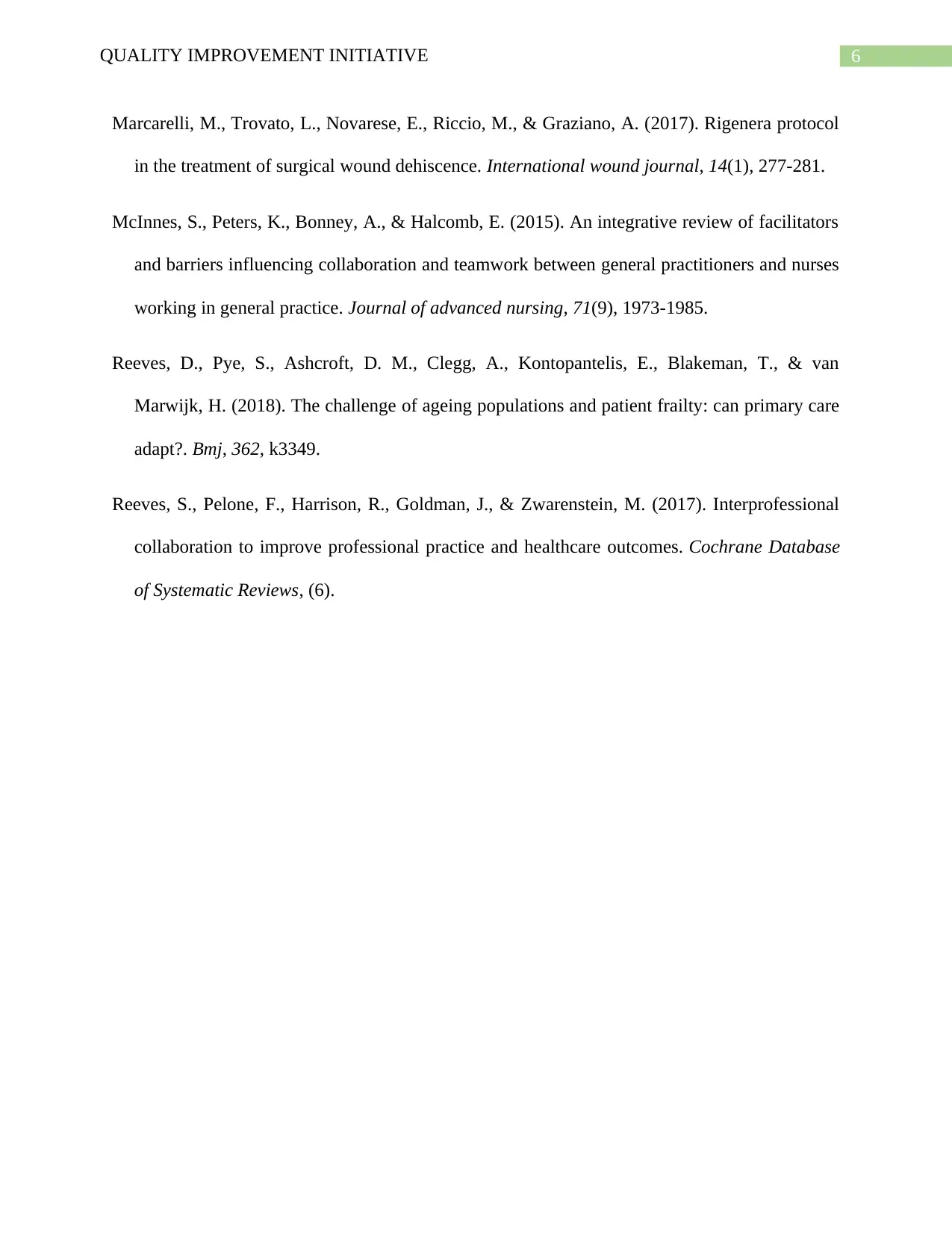
6QUALITY IMPROVEMENT INITIATIVE
Marcarelli, M., Trovato, L., Novarese, E., Riccio, M., & Graziano, A. (2017). Rigenera protocol
in the treatment of surgical wound dehiscence. International wound journal, 14(1), 277-281.
McInnes, S., Peters, K., Bonney, A., & Halcomb, E. (2015). An integrative review of facilitators
and barriers influencing collaboration and teamwork between general practitioners and nurses
working in general practice. Journal of advanced nursing, 71(9), 1973-1985.
Reeves, D., Pye, S., Ashcroft, D. M., Clegg, A., Kontopantelis, E., Blakeman, T., & van
Marwijk, H. (2018). The challenge of ageing populations and patient frailty: can primary care
adapt?. Bmj, 362, k3349.
Reeves, S., Pelone, F., Harrison, R., Goldman, J., & Zwarenstein, M. (2017). Interprofessional
collaboration to improve professional practice and healthcare outcomes. Cochrane Database
of Systematic Reviews, (6).
Marcarelli, M., Trovato, L., Novarese, E., Riccio, M., & Graziano, A. (2017). Rigenera protocol
in the treatment of surgical wound dehiscence. International wound journal, 14(1), 277-281.
McInnes, S., Peters, K., Bonney, A., & Halcomb, E. (2015). An integrative review of facilitators
and barriers influencing collaboration and teamwork between general practitioners and nurses
working in general practice. Journal of advanced nursing, 71(9), 1973-1985.
Reeves, D., Pye, S., Ashcroft, D. M., Clegg, A., Kontopantelis, E., Blakeman, T., & van
Marwijk, H. (2018). The challenge of ageing populations and patient frailty: can primary care
adapt?. Bmj, 362, k3349.
Reeves, S., Pelone, F., Harrison, R., Goldman, J., & Zwarenstein, M. (2017). Interprofessional
collaboration to improve professional practice and healthcare outcomes. Cochrane Database
of Systematic Reviews, (6).
1 out of 7
Related Documents
Your All-in-One AI-Powered Toolkit for Academic Success.
+13062052269
info@desklib.com
Available 24*7 on WhatsApp / Email
![[object Object]](/_next/static/media/star-bottom.7253800d.svg)
Unlock your academic potential
Copyright © 2020–2025 A2Z Services. All Rights Reserved. Developed and managed by ZUCOL.





